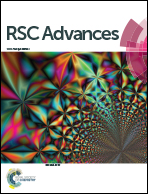Fabrication of an Ag/Fe2O3/ZnO ternary composite with enhanced photocatalytic performance†
Abstract
A novel Ag/Fe2O3/ZnO ternary composite was fabricated using the chemical deposition and photochemical deposition methods. Its structure and optical properties were characterized using X-ray diffraction (XRD), scanning electron microscopy (SEM), transmission electron microscopy (TEM) and ultraviolet-visible spectrophotometry. The Ag/Fe2O3/ZnO ternary composite exhibited a greater improvement in photocatalytic activity compared with the Fe2O3/ZnO or Ag/ZnO binary composite. The degradation rate of Ag/Fe2O3/ZnO towards methyl orange (MO) and iodoform (CHI3) within 120 min was 80% and 94%, respectively. More importantly, the Ag/Fe2O3/ZnO composite had a much higher degradation efficiency towards iodoform, which indicates its efficient and selective degradation characteristics. The results show that the Ag/Fe2O3/ZnO ternary composite holds great potential in the removal of carcinogenic iodoform from sewage.


 Please wait while we load your content...
Please wait while we load your content...